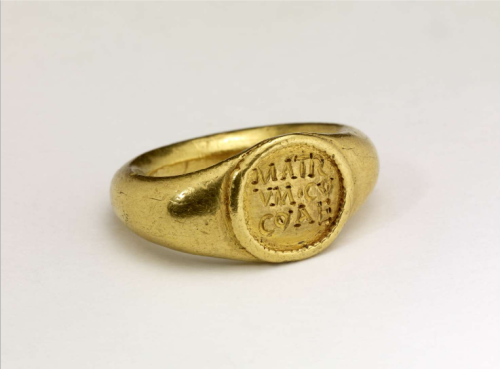#backworth
Silver skillet, with a highly decorated handle and some gilding. The bowl is deep, with slightly incurving walls forming a constriction in the line of the profile below the small everted rim.
The general theme of the decoration is the traditional one of acanthus scrolls and flowers, with some elements picked out by gilding. The central area of the handle carries the inscription MATR FAB / DVBIT in bold, neat lettering. The outlines of the letters are filled with a roughened surface to provide a key for the heavy gilding, perhaps more accurately termed ‘gold inlay’, which survives on the V, B and T of 'DVBIT’.
The skillet, part of the Backworth Hoard, bears a votive inscription dedicated to the Mother-Goddesses by a Fab(ius) Dubit(atus?).
The history of this hoard is obscure. We know that it was found around 1811, but not where it was found. The hoard was said to have included about 280 coins, but all but one of these, and probably other objects, were dispersed before The British Museum was able to acquire what was left of the treasure in 1850. The surviving coin is a denarius of Antoninus Pius (reigned AD 138-161) issued in AD 139.
The treasure was probably a votive deposit at a shrine of the Mother-goddesses near the eastern end of Hadrian’s Wall.
1st - 2nd century AD
© The Trustees of the British Museum
Post link
Gold finger-ring with slight flattening of the shoulders. The hoop is slightly bevelled in cross-section. The almost circular gem-setting is empty, and encircled at the rim with applied beaded wire, which is heavily worn. The floor of the setting has been scraped flat, but not polished, and bears a three-line inscription: MATR/VM CO/COAE. Although the exact translation is uncertain, this is certainly a votive gift to the Mother Goddesses. The inscription is probably secondary, engraved after a gemstone setting had been lost.
Found in Backworth (England), part of the Backworth Hoard.
The history of this hoard is obscure. We know that it was found around 1811, but not where it was found. The hoard was said to have included about 280 coins, but all but one of these, and probably other objects, were dispersed before The British Museum was able to acquire what was left of the treasure in 1850. The surviving coin is a denarius of Antoninus Pius (reigned AD 138-161) issued in AD 139.
The treasure was probably a votive deposit at a shrine of the Mother-goddesses near the eastern end of Hadrian’s Wall.
1st - 2nd century AD
© The Trustees of the British Museum
Post link



